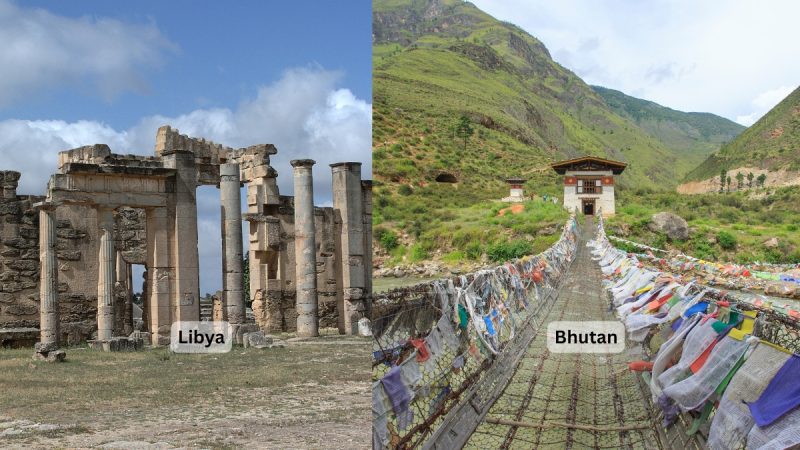Imagine a world where trains, a symbol of industrial connectivity and convenience, simply don’t exist. For some of the largest countries on the globe, this is reality. Despite vast distances and diverse terrains, these nations have no railway system. Countries like Libya, Chad, and Bhutan each find innovative ways to navigate their landscapes, relying on rugged roads, waterways, and air routes. Delve into the fascinating ways these countries keep moving forward, even with no railway system.
Countries In The World With No Railway System
1. Libya
Libya’s vast landscapes and major cities remain unlinked by railway, despite plans dating back to 1998 to modernise its rail infrastructure. Following the First Libyan Civil War in 2011, efforts to connect cities like Tripoli and Benghazi were suspended. Today, Libya relies mainly on an extensive road network and its ports for transportation, while travellers between cities often use buses, private cars, or flights due to limited alternatives.
2. Chad
Chad’s challenging desert terrain and limited infrastructure make railways a difficult and costly venture. Although French colonial planners envisioned a rail system connecting Chad to neighbouring Cameroon and Nigeria, the project never advanced. Today, Chad relies heavily on its sparsely paved roadways, especially in rural areas. In the southwest, rivers provide some transport options, but trucks and buses are the primary modes of transport for most residents and goods.
3. Niger
Though Niger attempted to establish a rail link from Niamey to Dosso in 2014, the project was ultimately abandoned. This abandoned stretch of track symbolises Niger’s struggle with infrastructure. With no railway system, Niger relies on road networks and shared taxis for travel between towns, and it uses the Niger River for some regional goods transport.
4. Somalia
Somalia had a brief railway history, with a line established by Italian colonists in the 1910s, but it was dismantled in the 1940s during British occupation. Today, Somalia’s challenging infrastructure and ongoing security issues have prevented the development of new railways. As a result, most transport depends on a mix of poorly maintained roads and small coastal ports for sea transport.
5. Yemen
Railways have long been considered a luxury Yemen couldn’t afford amid its economic challenges and civil unrest. Proposals for railways have come and gone, and even road maintenance is a struggle, with only a fraction of Yemen’s roads paved. Most goods and passengers rely on buses, private vehicles, and air transport for longer journeys.
6. Oman
Oman lacks a mainline railway network, relying instead on a well-maintained road system and the occasional scenic tourist train, such as the short route through Al Hoota Cave. In recent years, Oman has focused on highway projects and plans for a future national rail network spanning over 1,300 miles. Ports in Muscat and Salalah are essential for trade, while buses and cars handle most domestic travel.
7. Iceland
Iceland’s rugged volcanic landscape and low population density have made railways impractical. Most Icelanders and visitors use cars for transport, with the Ring Road encircling the country as the primary route for reaching major towns and tourist spots. Buses serve as the primary public transport option, and for long distances, especially during winter, air travel remains the most reliable means of moving around Iceland’s remote areas.
8. Bhutan
Rail transport is nonexistent in Bhutan, where steep mountains and deep valleys make railway construction particularly challenging. Although a proposed rail link from India could connect Bhutan’s southern regions, the country currently depends on its modest network of paved roads and two airports. The lack of major waterways limits internal transport options, making roadways critical for connecting towns and villages.
Even with no railway network, these countries find unique ways to stay connected and keep moving forward.
Cover Image Courtesy: Canva
For more such snackable content, interesting discoveries and the latest updates on food, travel and experiences in your city, download the Curly Tales App. Download HERE.

